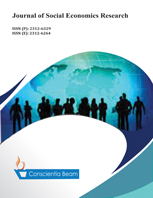The relationship between economic freedom and growth: Evidence from the Next Eleven (N-11) countries
DOI:
https://doi.org/10.18488/35.v11i2.3664Abstract
This study examines the association between economic freedom and economic growth in the Next Eleven (N-11) economies from 2001 to 2020. This paper also links the individual areas of economic freedom with growth in these countries. The study obtains economic freedom data from the Fraser Institute and the Heritage Foundation. It uses fixed effects and random effects techniques to examine the relationship between economic freedom and per capita income growth. The paper finds a positive association between economic freedom and growth in N-11 countries. The results also highlight that three areas of the economic freedom index (legal system & property rights, sound money, and free trade) are found to be positively associated with growth. In contrast, the other two areas (size of government and regulation) exhibit an insignificant relationship with growth. The results of this study highlight that N-11 countries with higher levels of economic freedom and better quality of economic institutions are likely to witness higher growth. Therefore, formulating policies that focus on improving the legal system, safeguarding property rights, maintaining a stable macroeconomic environment, and fostering free trade to facilitate economic progress in the N-11 countries is necessary.

